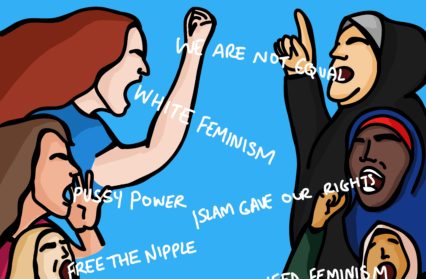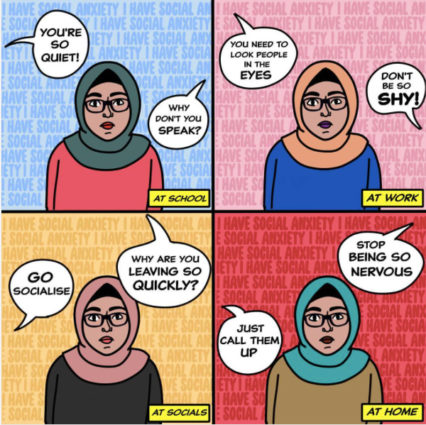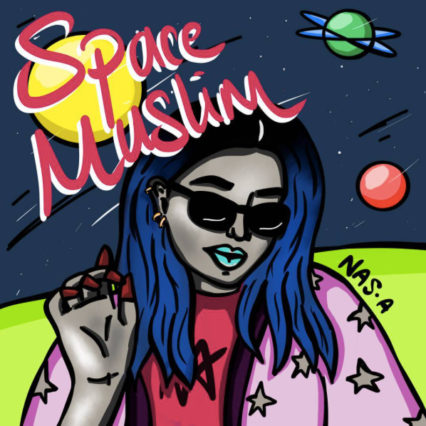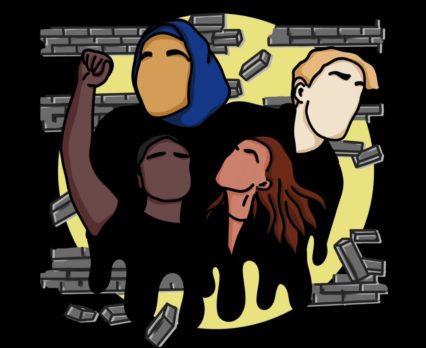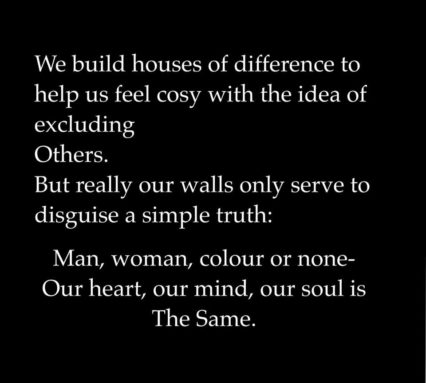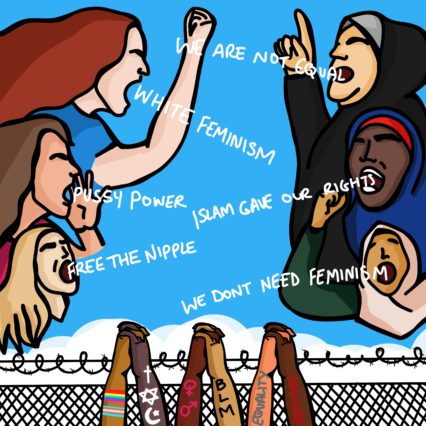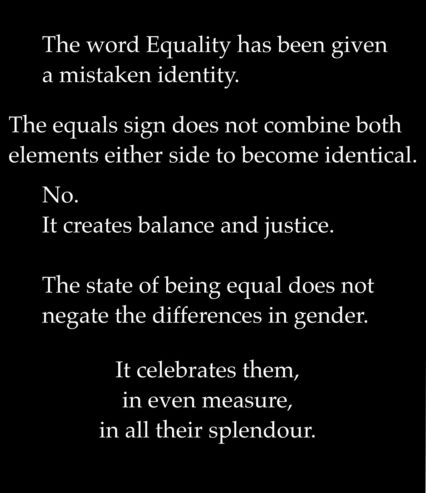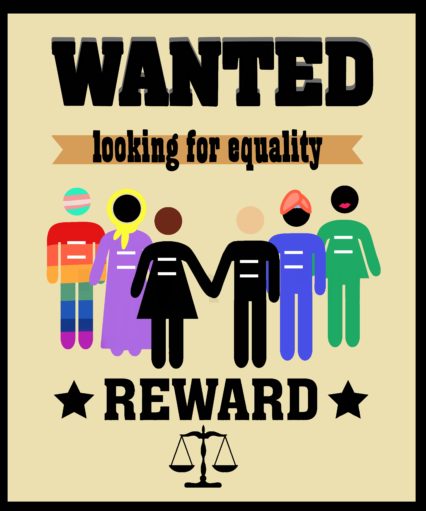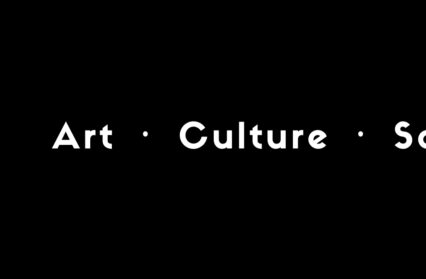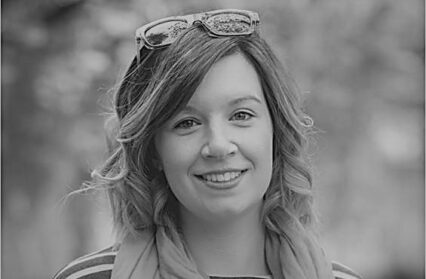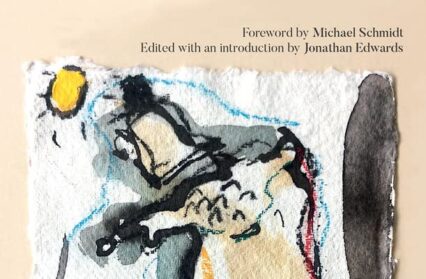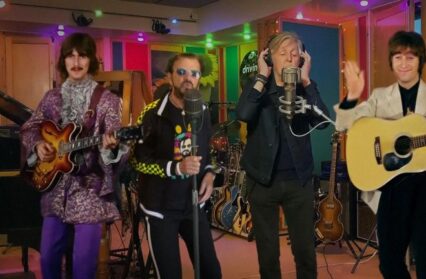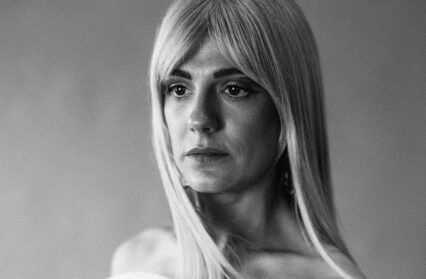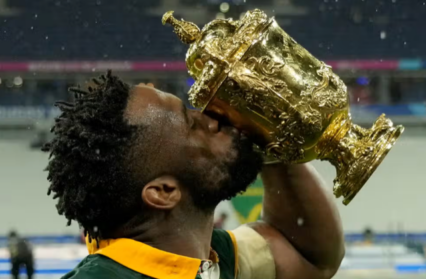I recently got the chance to connect with a group of Cardiff-based BAME feminists through the power of social media and networking (turns out that jargon word simply means going up to someone after a panel discussion on feminism and talking to them). One thing led to another and suddenly we’re befriending each other on Facebook, talking intersectional feminism, representation, and I’m being invited to a group that shouts nothing but solidarity and support for creative women and feminists in Cardiff. Which is how I came across Hanan Issa and her collaboration with Nasima Ahmed.
Hanan Issa is a Cardiff-based spoken word artist, poet, and writer. She’s a bi-racial (Welsh and Iraqi), on-the-fence feminist Muslim woman in a hijab. Her work covers many topics but mainly focuses on the female Muslim experience.
Nasima Ahmed is a marketing graduate from London, who, while looking for full-time employment, decided to share her illustrations online. Nasima’s illustrations aim to fill the lack of representation of Muslim girls/hijabis in the mainstream media.
“I wanted a space where girls like me could be represented in normal situations and be relatable. I also like to use my art as a way to voice my views and express feelings.” – Nasima
And her work does just that. Evidently inspired by pop art, Nasima portrays Muslim women through witty, unapologetic and colourful illustrations. The artwork also deals with topics ranging from social anxiety and alienation to self-love, culture and gender inequality.
Hanan and Nasima connected after Hanan purchased a jumper featuring Nasima’s artwork to wear to the women’s March in Cardiff, and expressed a desire to collaborate with her. The two got talking and “realized that they had had very similar experiences and had come to the same conclusion as to what the terms equality and feminism meant to them.” With the women’s marches taking place all over the globe instigating more dialogue around the concept of feminism, Hanan proposed that they create something that portrays their views on the term. Thus, this word/image project was born.
“Initially, the idea was to create one image but I wanted Hanan to incorporate her poetry so that our collaboration would be more impactful.”– Nasima
“We actually realized that we had similar experiences with others dictating to us what these terms “should” mean. Particularly in my experience, if we took conservative Muslims in one camp and then white stereotypical feminists in another camp, it was interesting as they were both telling me the same thing, which was that feminism is not for me. And something that Nasima and I talked about was that feminism is a sociopolitical concept that as such should be evolving as society develops and grows and evolves itself. And we couldn’t understand why that definition was solid and couldn’t be picked apart and changed.” – Hanan
Wanting to explore their views and share them with a wider audience through their respective art forms, the two came up with the following ideas:
“The first was the idea of open mindedness. And how, when we put up walls of solid definitions or solid ideas, then there is not much room for dialogue; we have to remember that essentially we’re all the same, and if you peel back anybody’s skin; man, woman, black, white, or however you identify yourself, you would be the same; your heart and your lungs, and everything’s the same.” – Hanan
The second idea explores how feminism “has become a bit of a shouting match” and what it can mean to different people:
The third idea is based on the idea of equality:
“To me, equality means fairness and the eradication of discrimination. For me, being bold for change means to be unapologetic.” – Nasima
Hanan and Nasima’s work highlights the extent to which feminism needs to be intersectional. The term ‘intersectionality’ was coined by Kimblere Crenshaw[1], and is a framework that calls for the need to approach gender inequality and oppression through a lens that takes into account race, class, ethnicity, religion and other factors. It is the idea that seeks to tackle the one-size-fits-all approach to feminism and recognises that, for instance, a black woman might experience inequality and oppression differently to a white woman due to the intersect of racism. Or in this case, how Muslim women’s lived experiences may differ from that of other women, yet through the lens of intersectionality, we can recognise all experiences as equally valid and important, without proclaiming one to be more ‘feminist’ than the other.
Art and poetry such as this, which challenges preconceived and misinformed ideas of Muslim women, who are often being spoken for or at in every direction, are important more than ever. Outside of our own echo chambers, there can be a lack of awareness and knowledge about the nuanced roles and identities Muslim women embody that extend beyond their physical appearance – like any other person. Much of this is owed to the fact that mainstream feminism, until recent years, has mostly adopted a ‘one size fits all’ approach rather than being inclusive and representative of all. I myself remember being an undergraduate and pouring over the feminist theorists in my university library, desperately trying to find someone, something I could relate to – something that was intersectional. Yet I have only discovered a feminism that reflects my experiences in the past year through the vast online community. In a world where the question of identity is at the forefront of every political, cultural and social debate, representation that validates your experiences is important. Art and literature, throughout history, has more often than not been reflective of its times and as we are unwantingly propelled towards the next few years of Brexit and Trump, we have a role to continue that tradition, to project our voices and of those from other groups that counter intolerant and reductive narratives. To quote the great political activist, feminist and writer, Angela Davis:
“Progressive art can assist people to learn not only about the objective forces at work in the society in which they live, but also about the intensity social character of their interior lives. Ultimately, it can propel people toward social emancipation.”
[1] http://socialdifference.columbia.edu/files/socialdiff/projects/Article__Mapping_the_Margins_by_Kimblere_Crenshaw.pdf


